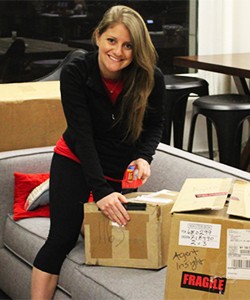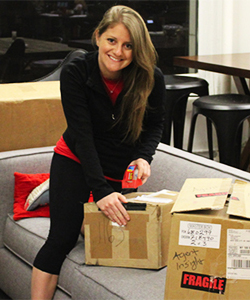
Dear movers, summer has just begun. Million people are already on the move. Busy phone lines and full trucks, best time of the year for our industry.
And every third customer you are dealing with was probably born between 1980 and 2000, in other words, a millennial. They are currently being the largest demographic group (a fact) and the first generation of real digital natives (indisputable). As that young generation has grown up in time of globalization and economic disruptions, they have a different set of behaviors and experiences than the previous generations.
If you think dealing with young customers gives you a hard time, then you just keep reading.

Jenna Weinerman, Marketing Director at Updater
Jenna Weinerman, Marketing Director at Updater, answers 4 critical questions about the millennial generation.
1. What are some key strategies movers should employ to successfully target younger customers?
I can understand why moving companies may want to target younger customers (younger equals lifetime customer, right?), but there are a few things to understand before you do. Firstly, let’s start by not calling young customers “Millennials.” This nickname covers a 20-year generational timeline, so by saying that you’re targeting “Millennials,” you’re kind of saying that you’re targeting “Americans.” Personally, I think it’s crazy to lump 80 million people together. When I’m strategizing about Updater’s marketing and thinking about reaching younger customers, I’m thinking in specifics – how many devices they use, what other brands they engage with, etc. Today’s technology allows us to target more specifically than ever before, so use that to your advantage.
That being said, you can always target “younger” consumers if you clearly define your age group. If your customer is very young, it could be their first ever move as adults. You can then tailor your service to their needs by providing additional guidance or advice during the process. Or, you might decide that in order to appeal to this young group, you need to be more accessible online. You could transparently display how your company prices its moves on your website, or make it easy for customers to contact you by enabling click-to-call functionality on mobile. There are a million ideas to implement on this front.
2. How should movers reshape the way they do business to better work with these customers?
It depends. Are you admittedly operating like it’s 1997, or have you transformed your company as technology improved? If you’re in the first camp, “reshaping” how you do business is likely a good idea anyway, regardless of whom you’re targeting. Again, I don’t think it’s necessarily the age of your customers that should inform and motivate business changes. Instead, it’s the simple fact that we live in 2016 and your customers will want to know (immediately) if your driver is running five minutes late, among other expectations.
One piece of advice I’d give every moving company: if you don’t offer online price quotes, get that functionality set up on your site as soon as you can. At very least, allow prospects to fill out a “quote request form” on your site so that a member of your team can get back to the prospect later.
3. What are some real examples of stellar customer care?
One of our clients in Minnesota, AAA Movers, shared with us a touching story about saving a customer’s dog. It was winter and they were moving a customer who lived on a lake. The customer’s dog wandered onto the frozen lake, got stuck on ice and fell through. The crew on the job saw this happen and, using their moving straps, maneuvered one of the crew members out onto the thin ice to help rescue the dog from the freezing water. I think that’s an amazing example of teamwork and going above and beyond the call of duty.
Acts of heroism aside, the principle I always try to follow is to treat customers as I’d want to be treated. I know it’s cliché, but it works. If I think it’d be nice that my movers had brought water bottles to distribute on a hot day, then I’d do that. If I’ve dreamed of a tool to handle all the tasks complementary to the actual hauling and lifting, then I’d offer Updater. Do what you would expect from the experience.
4. What disruptions will we see in the near future that will be provoked by the “Millennials”?
That’s a great question – there are tons of ways to slice and dice this. I think product innovation in this industry is a definite given, and Updater is an example of that. But I don’t think that novel products alone constitute disruption. More and more, customers won’t want to be bothered with comparing quotes or waiting for in-home estimates to take place. Companies have taken note of this and it’s no surprise that on-demand products and services are becoming more popular. Quicken Loans, for example, offers “Rocket Mortgage,” allowing clients to “push button, get mortgage.” Obviously, you can’t get a mortgage with just one click, but the perception is that you can and using Quicken Loans will be a fast, painless process. I suspect that, right now, the larger trend toward instant gratification will disrupt the moving industry far more than changes to how moves are physically accomplished.
What’s even more important regarding “Millennial” disruption in our industry might be happening in your own office. Based on my professional experiences, I’ve observed that young employees expect and are comfortable with change. Whether it’s switching to a more environmentally friendly supplier or introducing a social customer care policy to respond to Twitter complaints, they find innovative ways to revise existing business practices. If I had to sum up young employees, I’d say that they want the freedom to make choices that make a tangible impact. For a moving company, this could mean recognizing that younger workers want to grow and to feel like they’re part of a larger community outside your company. Why not invite them to speak with some of your vendors, or encourage them to participate in the AMSA leaders program? Paying attention to their career development and industry training benefits you in the long run – adapting and evolving applies to the workplace, too!
Thank you for sharing your professional opinion and practical advice with us, Jenna Weinerman.